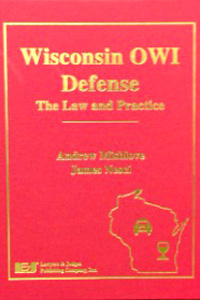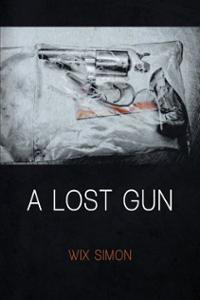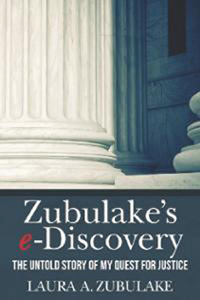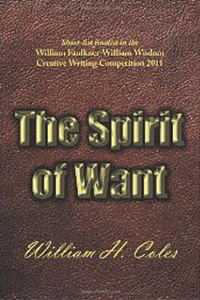Want to Review a Book?
Have you read a great book that would be of interest to State Bar members? Or one that you want to make sure no one else wastes their time reading? Be a reviewer! Contact us at wislawmag@wisbar.org.
Price Correction:
Alcohol Beverages Regulation in Wisconsin
By Aaron R. Gary (Madison, WI: State Bar of Wisconsin PINNACLE©, 2012). The review of this book in the July/August issue listed an incorrect member price. The correct member price is $219. The nonmember price remains $235. Order, www.wisbar.org.
 Verdict: Touchdown
Verdict: Touchdown
Wisconsin OWI Defense – The Law and Practice
By Andrew Mishlove & James Nesci (Tucson, AZ: Lawyers & Judges Publishing Co. 2013). 336 pgs. $165. Order, www.lawyersandjudges.com.
Reviewed by Christopher L. Kuehn
This is the best book I have read pertaining to Wisconsin operating-while-intoxicated (OWI) law, and one of the best in dealing with the substance of OWI law (though I have yet to see one better than Michigan’s Drunk Driving, Law and Practice). The book calls itself a “how to guide for everything from running a OWI defense practice to trying a defense OWI case.” It has at least reached its second goal, and done so admirably.
The book’s layout is well thought out. The authors seek to advise lawyers not only how to handle cases but also how to handle their practices. Some of the more unusual topics for a book of this type include advertising, client relations, and plea negotiations. One would think this coverage would be common in a criminal defense treatise, but it is quite rare, especially when you have OWI cases in which prosecutors at best are limited to sentence bargaining.
The only thing I would have preferred would have been a full chapter on sentencing. The book has very little on that. I have noticed that often the best thing you can do for a client is prepare him or her for sentencing. The subheading does provide at least the right road to go down in such situations.
I found valuable the discussion of attacking the horizontal-gaze-nystagmus test and drug recognition experts (DREs). The book contains forms, and a CD includes all the most recent NHTSA studies, standardized field sobriety test (SFST) training manuals, SFST training videos, and DRE training manuals. All are very helpful for preparing for trial, and again, convenient to have in one location.
I also liked the practice tips throughout the book. One of the most interesting concerned the use of mailing labels in voir dire. Also, the model cross-examinations in this book are very well laid out and appear to be from actual trials (as indicated by the absence of Perry Mason-type “gotcha” questions). Instead, the models lay out basic, no-nonsense attacks that jurors should follow easily.
I would recommend this book both to novices looking to handle their first OWI cases and to experienced attorneys who would like a ready reference for up-to-date legal research. I was also impressed with the book’s timeliness; it discusses a U.S. Supreme Court decision, Missouri v. McNeely, released in April 2013. It appears that the authors’ dedication to getting this book “right” went beyond the first submission to the editor. This book is a very valuable resource.
Christopher L. Kuehn, Thomas Cooley 2001 cum laude, is a partner in Kuehn & Flitcroft LLP, Elkhorn, and primarily focuses on criminal defense and family law matters.
 Verdict: It’s a Keeper
Verdict: It’s a Keeper
A Lost Gun
By Wix Simon (iUniverse 2012). 224 pgs. $15.95 (paperbound). Order, bookstore.iuniverse.com.
Reviewed by Richard Ebbott
Jessie Sands, a relatively new homicide detective in the Cobb County, Georgia, sheriff’s department, confronts the perp of a family massacre on a bridge over the Chattahoochee River. Shots are fired, and both guns end up in the river. Which one is the “lost gun” in the title of this mystery by Wix Simon is not a mystery because the gun is depicted on the book’s cover. The life of Jessie Sands after the shooting on the bridge takes readers on a winding trail through Cobb County, Fulton County, and Atlanta itself.
Wix Simon has crafted an enjoyable read in this 224-page trade soft-cover, self-published with iUniverse, where Simon is a rising star. Simon worked for the Environmental Protection Agency for many years and is now a consultant. He previously authored A Toxic Assault, plays the fiddle, and enjoys black-and-white photography.
Now back to the mystery. Because of the shooting, Jessie knows that she will be facing an internal affairs investigation. But before she can pull herself together to deal with that, she has to deal with Sgt. Ron Niles (Rusty Nails) of the Fulton County sheriff’s department. He has just come from the airport motel, where he exacted sex from a woman he stopped for speeding.
Weave into the trail Jennifer Richards, a beautiful 17 year old who has been at odds with her overbearing lawyer father for the last four years. Jennifer runs away from home and ends up in a community called the Caring Arms of Love, founded by one John Wright. Jennifer must have been on the challenged side of naïve, because she buys into Wright’s “mission” to shelter runaway teenagers. A question for the reader is whether Caring Arms of Love is in fact a haven for teenagers at risk, a cult, or something far more sinister. Enter, too, Detective Bud Prior, newly appointed to the internal affairs department of the Atlanta Police Department. Bud is investigating corruption within area law-enforcement departments, including youth gang activity somehow connected to the police. Bud sides with Jessie Sands (perhaps to an extreme) on her internal-affairs problem.
Although the book is a good read, it is not without shortcomings. The characters seem to be more typecast than actual complex individuals. Many of the events and motives for the actors are thinly drawn and highly improbable. Some facts, such as a single-pilot Learjet, are inaccurate. But for all that, the reader is drawn into a battle between good and evil, in which what should be good may be truly evil and what is mostly good may not survive.
Richard H. Ebbott, U.W. 1967, formerly a Rock County assistant district attorney, practices law in Flint, Mich., primarily doing civil trial work.
 Verdict: It’s a Keeper
Verdict: It’s a Keeper
Zubulake’s E-Discovery: The Untold Story of My Quest for Justice
By Laura A. Zubulake (Laura A. Zubulake, 2012). 230 pgs. $25.95. Order, www.amazon.com.
Reviewed by Neal S. Krokosky
Zubulake’s E-Discovery chronicles the employment-discrimination lawsuit Laura Zubulake filed against UBS Warburg LLC, UBS Warburg, and UBS AG. Zubulake, a nonattorney, analyzes the strategies she considered, the decisions she made, “and the resulting judicial rulings that changed the discovery phase of litigation.”
Zubulake, an institutional generalist salesperson when she filed suit, begins with an insider’s look at Wall Street. The most relevant takeaway is that a business that thrives on information sharing via electronic means, for example, email, provides a fertile ground for electronic discovery.
Once she has set the scene, Zubulake primarily focuses on electronic discovery and the difficulties she encountered in conducting that activity. She acknowledges “there are two sides to every argument” but admits the book represents neither the defendants’ case nor her attorneys’ accounts of events.
For attorneys, the book’s central lesson is that one should have a plan before engaging in electronic discovery. To create a plan, an attorney must know what he or she is looking for and the best ways to find it. The nature of the claim may help define the relevant time period, and the client likely will have helpful, if not complete, knowledge regarding sources. The attorney still must determine how to effectively sift through the mountain of information. If the attorney and the client lack the capacity to do so on their own, they should consider hiring a third party to provide the necessary support.
An attorney with a basic understanding of electronic discovery likely will not benefit as much as a new attorney from reading the book. Two groups that might benefit from reading the book are law students and parties to a lawsuit.
For law students, especially those in civil procedure or trial advocacy classes, the book provides important insights that are rarely discussed as part of the curriculum. First, a client can be a resource. Second, litigation can be stressful for both client and attorney. Third, litigation is a process. Regarding the process, when reviewing discovery answers (the book’s focus), it pays to ask whether answers make sense. If not, determine why and respond accordingly.
Parties to a lawsuit, especially those unfamiliar with the litigation process, also may find this book a good resource. Zubulake provides unique insights from her role as a party. The litigation process takes time, and each decision influences the next. Therefore, it is important to stay engaged. Also, a client must try to trust his or her attorney’s knowledge, skills, and experience. Not all attorneys are the same.
As a story, this book was interesting and occasionally insightful. As a practice tool, it will be less helpful for an attorney with a basic knowledge of electronic discovery than a new attorney, law student, or party to a lawsuit.
Neal S. Krokosky, U.W. 2009, practices at Weiss Berzowski Brady, LLP, Milwaukee, and focuses on commercial and employment litigation.
 Verdict: Maybe for You, Not for Me
Verdict: Maybe for You, Not for Me
The Spirit of Want
By William H. Coles (Bloomington, Ind.: AuthorHouse 2013). 292 pgs. $14.36. Order, www.amazon.com.
Reviewed by Dustin T. Woehl
This book is about two sisters, the men they love, and the choices they make. The Spirit of Want follows the sisters and several other people with whom they interact. It starts with a physician, Luke Osborne, at a party in 1984. He meets the two daughters of his boss. One daughter, Lucy, is described (with a typical abundance of modifiers) as “a light-bronze skinned, dark-eyed, stunningly beautiful woman of thirty-four or five” and “a lawyer famous for little tolerance for inferior intelligence” (4). Luke appreciates Lucy’s beauty but not her confrontational demeanor. Lucy is bored, and perhaps a little put off by Luke’s job as a retinal surgeon. The “not unattractive” daughter, Elizabeth, who loves children and writes children’s books, is more friendly. She recedes until later in the book.
Lucy, although extremely intoxicated, offers Luke a ride home, and their trip ends with the car in a ditch, Luke injured, and Lucy possibly having struck and killed a woman. Luke is the only witness. This perhaps leads Lucy to reconsider her feelings toward Luke, although it might just be a coincidence. Anyway, they spend time together, Luke falls in love with Lucy, and they marry. The two get along about as well as their first meeting would have predicted.
The book’s plot elements are not clearly demarked. Instead of a readily identifiable exposition, rising action, conflict, crisis, dénouement, and conclusion, things – many of them quite interesting – just continue to happen until the book ends. While I missed the familiar plot structure while reading, the book improves on retrospection. One can look at the plot like a life completed, picking out themes and finding meaning that might not have been apparent in the midst. In that sense, the book has lingered with me, providing food for thought, contemplation, and replaying.
For fear of spoiling this enjoyment, I will only say that through the rest of the book, Lucy makes bad choices while Luke and Elizabeth make better choices. Oh, there also are an escape to Africa, a political campaign, medical malpractice, legal malpractice, a cover-up, drinking, drugs, sex, a TV minister, and ethics violations galore.
Although the book’s plot is expansive and intriguing, it is somewhat flat in the presentation. The action changes, but the characters change very little, and even to the extent they grapple, think, or debate, it doesn’t strike a chord or bring a fresh perspective. The book hints at some depth and interesting topics, such as father-daughter relationships, medical malpractice, and television ministries. It does so without any fresh angles or new ideas, however. For example, Lucy assumes Luke hates lawyers, and he responds rather blandly by reciting his opinion that there are many unnecessary lawsuits.
Ultimately, this book failed to draw me in with realistic dynamic characters facing dilemmas I wanted to see them work through. It did, though, offer enough food for thought to keep me ruminating, replaying, and rearranging long after I finished the last chapter.
Dustin T. Woehl, Univ. of Pennsylvania 2000, is in practice with Kasdorf, Lewis & Swietlik S.C., Milwaukee.
